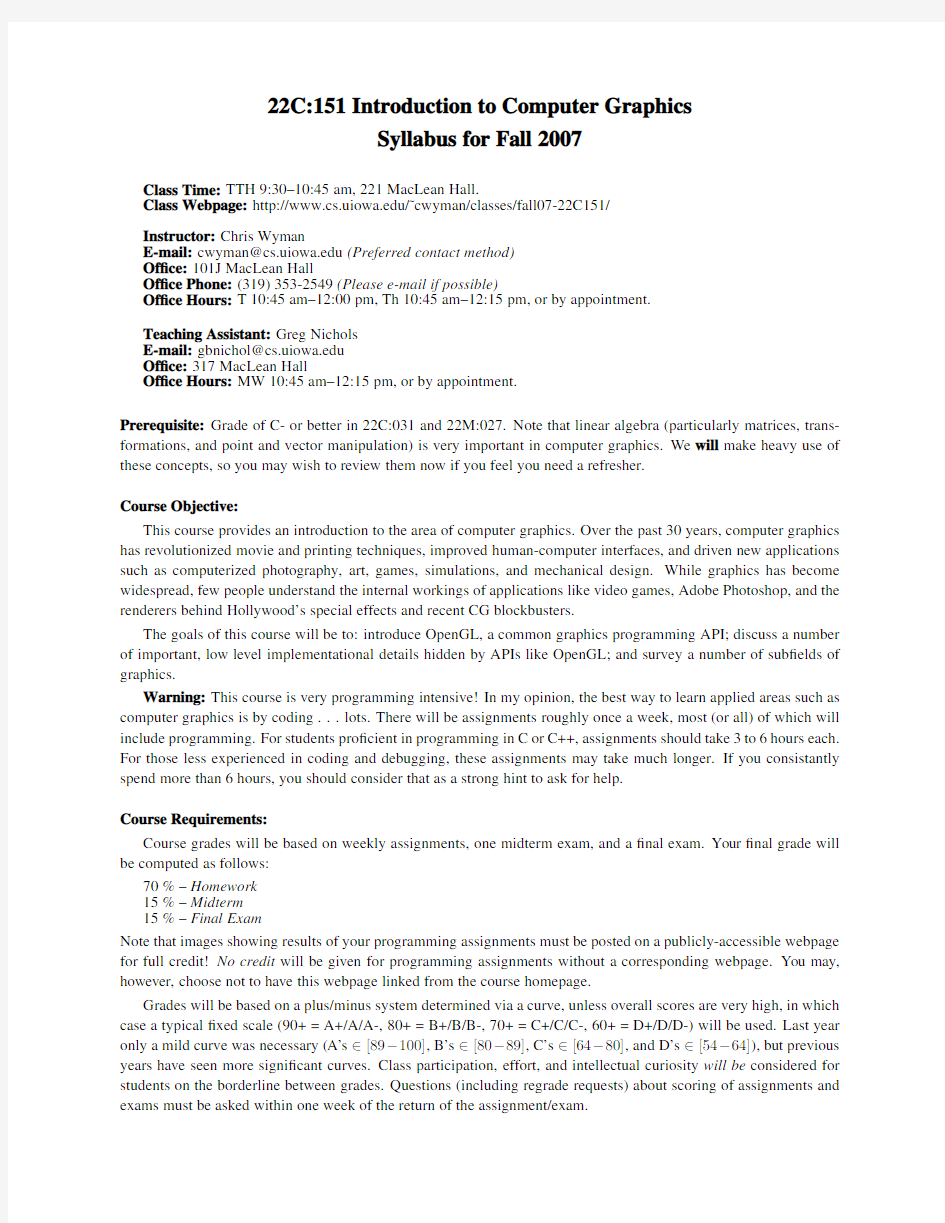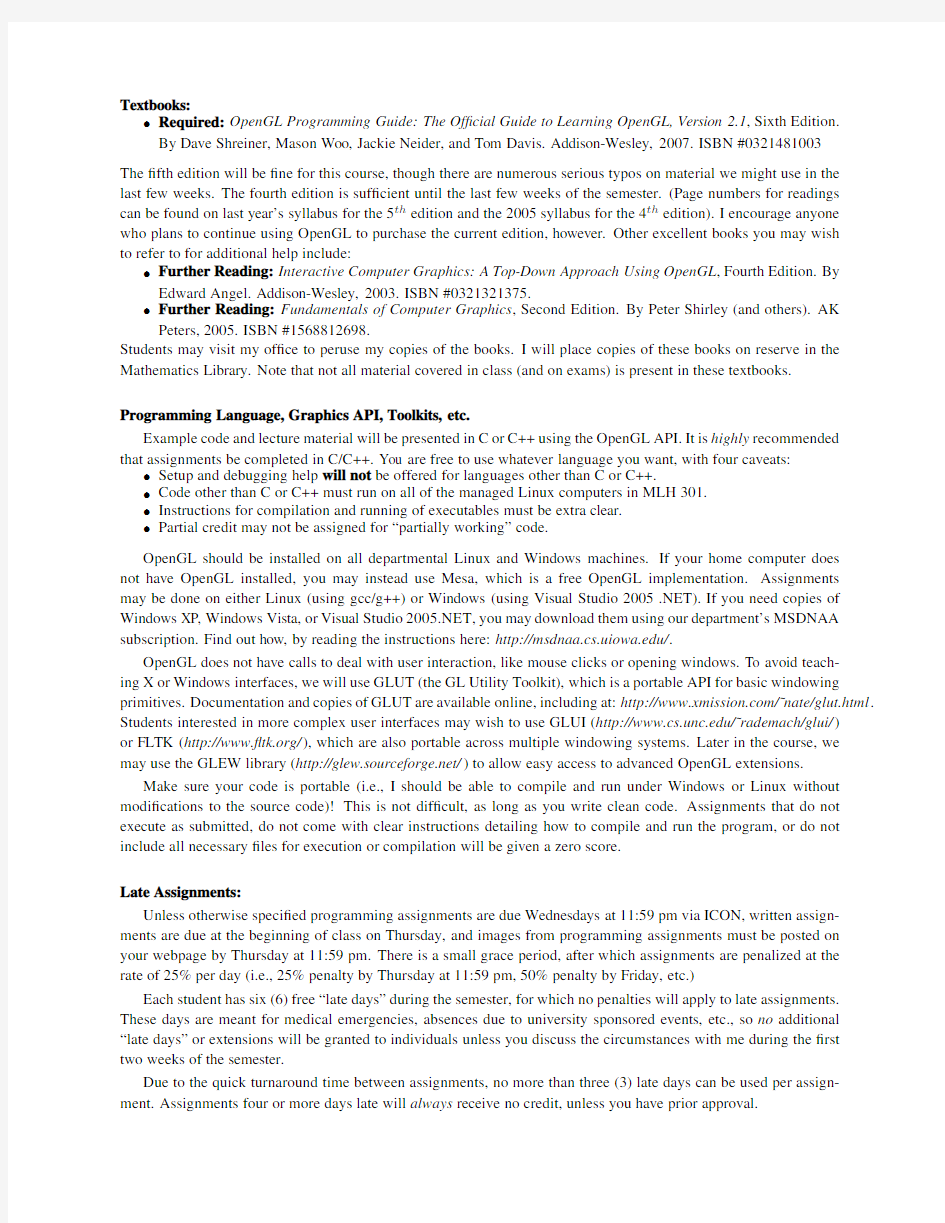

22C:151Introduction to Computer Graphics
Syllabus for Fall2007
Class Time:TTH9:30–10:45am,221MacLean Hall.
Class Webpage:https://www.doczj.com/doc/e73086343.html,/?cwyman/classes/fall07-22C151/
Instructor:Chris Wyman
E-mail:cwyman@https://www.doczj.com/doc/e73086343.html,(Preferred contact method)
Of?ce:101J MacLean Hall
Of?ce Phone:(319)353-2549(Please e-mail if possible)
Of?ce Hours:T10:45am–12:00pm,Th10:45am–12:15pm,or by appointment.
Teaching Assistant:Greg Nichols
E-mail:gbnichol@https://www.doczj.com/doc/e73086343.html,
Of?ce:317MacLean Hall
Of?ce Hours:MW10:45am–12:15pm,or by appointment.
Prerequisite:Grade of C-or better in22C:031and22M:027.Note that linear algebra(particularly matrices,trans-formations,and point and vector manipulation)is very important in computer graphics.We will make heavy use of these concepts,so you may wish to review them now if you feel you need a refresher.
Course Objective:
This course provides an introduction to the area of computer graphics.Over the past30years,computer graphics has revolutionized movie and printing techniques,improved human-computer interfaces,and driven new applications such as computerized photography,art,games,simulations,and mechanical design.While graphics has become widespread,few people understand the internal workings of applications like video games,Adobe Photoshop,and the renderers behind Hollywood’s special effects and recent CG blockbusters.
The goals of this course will be to:introduce OpenGL,a common graphics programming API;discuss a number of important,low level implementational details hidden by APIs like OpenGL;and survey a number of sub?elds of graphics.
Warning:This course is very programming intensive!In my opinion,the best way to learn applied areas such as computer graphics is by coding...lots.There will be assignments roughly once a week,most(or all)of which will include programming.For students pro?cient in programming in C or C++,assignments should take3to6hours each. For those less experienced in coding and debugging,these assignments may take much longer.If you consistantly spend more than6hours,you should consider that as a strong hint to ask for help.
Course Requirements:
Course grades will be based on weekly assignments,one midterm exam,and a?nal exam.Your?nal grade will be computed as follows:
70%–Homework
15%–Midterm
15%–Final Exam
Note that images showing results of your programming assignments must be posted on a publicly-accessible webpage for full credit!No credit will be given for programming assignments without a corresponding webpage.You may, however,choose not to have this webpage linked from the course homepage.
Grades will be based on a plus/minus system determined via a curve,unless overall scores are very high,in which case a typical?xed scale(90+=A+/A/A-,80+=B+/B/B-,70+=C+/C/C-,60+=D+/D/D-)will be https://www.doczj.com/doc/e73086343.html,st year only a mild curve was necessary(A’s∈[89?100],B’s∈[80?89],C’s∈[64?80],and D’s∈[54?64]),but previous years have seen more signi?cant curves.Class participation,effort,and intellectual curiosity will be considered for students on the borderline between grades.Questions(including regrade requests)about scoring of assignments and exams must be asked within one week of the return of the assignment/exam.
Textbooks:
?Required:OpenGL Programming Guide:The Of?cial Guide to Learning OpenGL,Version2.1,Sixth Edition.
By Dave Shreiner,Mason Woo,Jackie Neider,and Tom Davis.Addison-Wesley,2007.ISBN#0321481003
The?fth edition will be?ne for this course,though there are numerous serious typos on material we might use in the
last few weeks.The fourth edition is suf?cient until the last few weeks of the semester.(Page numbers for readings
can be found on last year’s syllabus for the5th edition and the2005syllabus for the4th edition).I encourage anyone who plans to continue using OpenGL to purchase the current edition,however.Other excellent books you may wish
to refer to for additional help include:
?Further Reading:Interactive Computer Graphics:A Top-Down Approach Using OpenGL,Fourth Edition.By Edward Angel.Addison-Wesley,2003.ISBN#0321321375.
?Further Reading:Fundamentals of Computer Graphics,Second Edition.By Peter Shirley(and others).AK Peters,2005.ISBN#1568812698.
Students may visit my of?ce to peruse my copies of the books.I will place copies of these books on reserve in the Mathematics Library.Note that not all material covered in class(and on exams)is present in these textbooks.
Programming Language,Graphics API,Toolkits,etc.
Example code and lecture material will be presented in C or C++using the OpenGL API.It is highly recommended
that assignments be completed in C/C++.You are free to use whatever language you want,with four caveats:?Setup and debugging help will not be offered for languages other than C or C++.
?Code other than C or C++must run on all of the managed Linux computers in MLH301.
?Instructions for compilation and running of executables must be extra clear.
?Partial credit may not be assigned for“partially working”code.
OpenGL should be installed on all departmental Linux and Windows machines.If your home computer does
not have OpenGL installed,you may instead use Mesa,which is a free OpenGL implementation.Assignments may be done on either Linux(using gcc/g++)or Windows(using Visual https://www.doczj.com/doc/e73086343.html,).If you need copies of Windows XP,Windows Vista,or Visual https://www.doczj.com/doc/e73086343.html,,you may download them using our department’s MSDNAA subscription.Find out how,by reading the instructions here:https://www.doczj.com/doc/e73086343.html,/.
OpenGL does not have calls to deal with user interaction,like mouse clicks or opening windows.To avoid teach-
ing X or Windows interfaces,we will use GLUT(the GL Utility Toolkit),which is a portable API for basic windowing primitives.Documentation and copies of GLUT are available online,including at:https://www.doczj.com/doc/e73086343.html,/?nate/glut.html. Students interested in more complex user interfaces may wish to use GLUI(https://www.doczj.com/doc/e73086343.html,/?rademach/glui/)
or FLTK(http://www.?https://www.doczj.com/doc/e73086343.html,/),which are also portable across multiple windowing https://www.doczj.com/doc/e73086343.html,ter in the course,we may use the GLEW library(https://www.doczj.com/doc/e73086343.html,/)to allow easy access to advanced OpenGL extensions.
Make sure your code is portable(i.e.,I should be able to compile and run under Windows or Linux without modi?cations to the source code)!This is not dif?cult,as long as you write clean code.Assignments that do not execute as submitted,do not come with clear instructions detailing how to compile and run the program,or do not include all necessary?les for execution or compilation will be given a zero score.
Late Assignments:
Unless otherwise speci?ed programming assignments are due Wednesdays at11:59pm via ICON,written assign-ments are due at the beginning of class on Thursday,and images from programming assignments must be posted on your webpage by Thursday at11:59pm.There is a small grace period,after which assignments are penalized at the
rate of25%per day(i.e.,25%penalty by Thursday at11:59pm,50%penalty by Friday,etc.)
Each student has six(6)free“late days”during the semester,for which no penalties will apply to late assignments. These days are meant for medical emergencies,absences due to university sponsored events,etc.,so no additional “late days”or extensions will be granted to individuals unless you discuss the circumstances with me during the?rst
two weeks of the semester.
Due to the quick turnaround time between assignments,no more than three(3)late days can be used per assign-ment.Assignments four or more days late will always receive no credit,unless you have prior approval.
Academic Honesty:
Academic dishonesty of any kind will not be tolerated.Unless otherwise stated in class,all assignments and exams are to be completed individually.While discussion of ideas and problems with fellow students is encouraged,
code and written homeworks must be done individually.In certain circumstances,code fragments may be provided to eliminate tedious coding or to provide a common framework for all students.All other code must be original.
Online resources may be used to help you understand the material,but copying online code is grounds for failure. Period.As a continuum exists ranging through reading a textbook-like online resource,examining online code to
help?nd bugs in your own,posting questions in online forums,writing your code while examining online code,and explicit copying,I encourage you to discuss such behaviors with me before utilizing them.Discussion after the fact
is too late,and may lead to failure.If you?nd yourself relying on such resources to a greater and greater extent,you
need to make an appointment with me so I can help clarify the course material.
For clari?cation on what constitutes academic dishonesty,contact me or consult the printed policy in the Schedule
of Courses,the CLAS Bulliten,or online at https://www.doczj.com/doc/e73086343.html,/faculty/teaching/classroom p&p/acad fraud etc.shtml. Clari?cation must occur before you turn in questionable work.
Further Considerations:
Makeup exams will not be given,except in circumstances allowed under the University of Iowa’s policy on ab-sences from examinations(see:https://www.doczj.com/doc/e73086343.html,/faculty/teaching/classroom p&p/general exam p&p.shtml).
If a makeup exam is necessary,please inform me as far in advance as possible.
I need to hear from any student with a disability that requires modi?cation to seating,testing,or other class require-ments.Please talk with me as soon as possible during of?ce hours,so that appropriate arrangements can be made in a timely fashion.For more information on the procedures refer to: https://www.doczj.com/doc/e73086343.html,/faculty/teaching/classroom p&p/disabilities.shtml
Note:As a course offered by the College of Liberal Arts and Sciences,course policies are governed by the CLAS.
Complaints:
If you have complaints,please feel free to discuss them directly with me during of?ce hours or via e-mail.If
you have problems with the TA,please attempt to resolve them with her?rst before contacting me.If you do not
feel I have appropriately dealt with your complaint,you should consult the Computer Science DEO/Chair,Professor
Jim Cremer,14D MacLean Hall,(319)335-1713,cremer@https://www.doczj.com/doc/e73086343.html,.If still unresolved,complaints must be submitted in writing to(for undergrads)Helena Dettmer,the CLAS Associate Dean for Academic Programs,or(for grads)to Eric Wurster,Graduate College Associate Dean for Academic Affairs.Further information about this policy
is available at:https://www.doczj.com/doc/e73086343.html,/students/academic handbook/ix.shtml#4.
Additional References:
Additional books that may prove helpful or interesting include:
?Computer Graphics:Principles and Practice,Second Edition in C.By James Foley,Andries van Dam,Steven
Feiner,and John Huges.Addison-Wesley,1997.ISBN#020*******
?Ray Tracing from the Ground Up.By Kevin Suffern.A K Peters,2007.ISBN#1568812728.
?Realistic Ray Tracing,Second Edition.By Peter Shirley and R.Keith Morley.A K Peters,2003.ISBN
#1568811985.
?Physically Based Rendering.By Matt Pharr and Greg Humphreys.Morgan Kaufmann,2004.ISBN#012553180X. These books are available for you to peruse in my of?ce,and some of them are available from the library.
Tentative schedule:
Topic Assignment Due Suggested Readings August28Intoduction&Expectations,
OpenGL State Machine,PPM?les
August30Introduction to OpenGL and GLUT Red Book:Ch1,Appendix D
Interactive CG:Ch1 September4Line Drawing Algorithms Interactive CG:7.8,7.9
Fundamentals:3.5 September6Line Drawing Algorithms Asgn#1Due Red Book:p.27–55
September11Triangle Rasterization Interactive CG:7.10,7.11
Fundamentals:3.6 September13Triangle Rasterization,Asgn#2Due Red Book:p.55–65
Linear Algebra Review Interactive CG:4.1,4.2 September18Linear Algebra Review,Interactive CG:Appendices B,C
Homogeneous Coordinates,Interactive CG:4.3,4.4,4.6–4.8
Transformations Fundamentals:2.3,2.4,5,6 September20Transformations,Asgn#3Due Red Book:Appendix F,Ch3
Perspective,Perspective Matrix,Interactive CG:5.1–5.5 September25Perspective in OpenGL Fundamentals:Ch7
Matrix Stack
September27Z-Buffer Asgn#4Due Interactive CG:5.6,7.11
3D Depth in OpenGL Red Book:p.185–187,468–471 October2Barycentric Coordinates Red Book:Ch4
Basic Color Perception Red Book:p.220–225
Phong Illumination Model Fundamentals:2.11,9.2,20 October4Gouraud&Phong Shading Asgn#5Due Red Book:Ch5
OpenGL Lighting Interactive CG:Ch6 October9Texture Mapping Red Book:Ch9
Fundamentals:Ch11 October11Texture Mapping Asgn#6Due
October16Questions&Review for Midterm
October18Midterm Exam
October23Shadows,Shadow Maps Redbook:p.459–461,612–622
Interactive CG:5.10 October25OpenGL Shadow Mapping Asgn#7Due
October30Introduction to Raytracing Interactive CG:12.2–12.4
November1Raytracing Fundamentals:Ch10
November6Raytracing
November8Raytracing(and Pathtracing)Asgn#8Due Fundamentals:Ch23
November13(Advanced Topic)
November15(Advanced Topic)Asgn#9Due
November20Thanksgiving Break
November22Thanksgiving Break
November27(Advanced Topic)
November29(Advanced Topic)Asgn#10Due
December4(Advanced Topic)
December6(Advanced Topic)
December11(Advanced Topic)
December13Review for Final Examination Asgn#11Due
December18Final Exam(Tuesday at2:15-4:15pm)
Some potential topics for the last weeks of class include:modern(programmable)graphics hardware,Bezier curves, radiosity,advanced raytracying or pathtracing,non-photorealistic rendering,and scienti?c visualization.